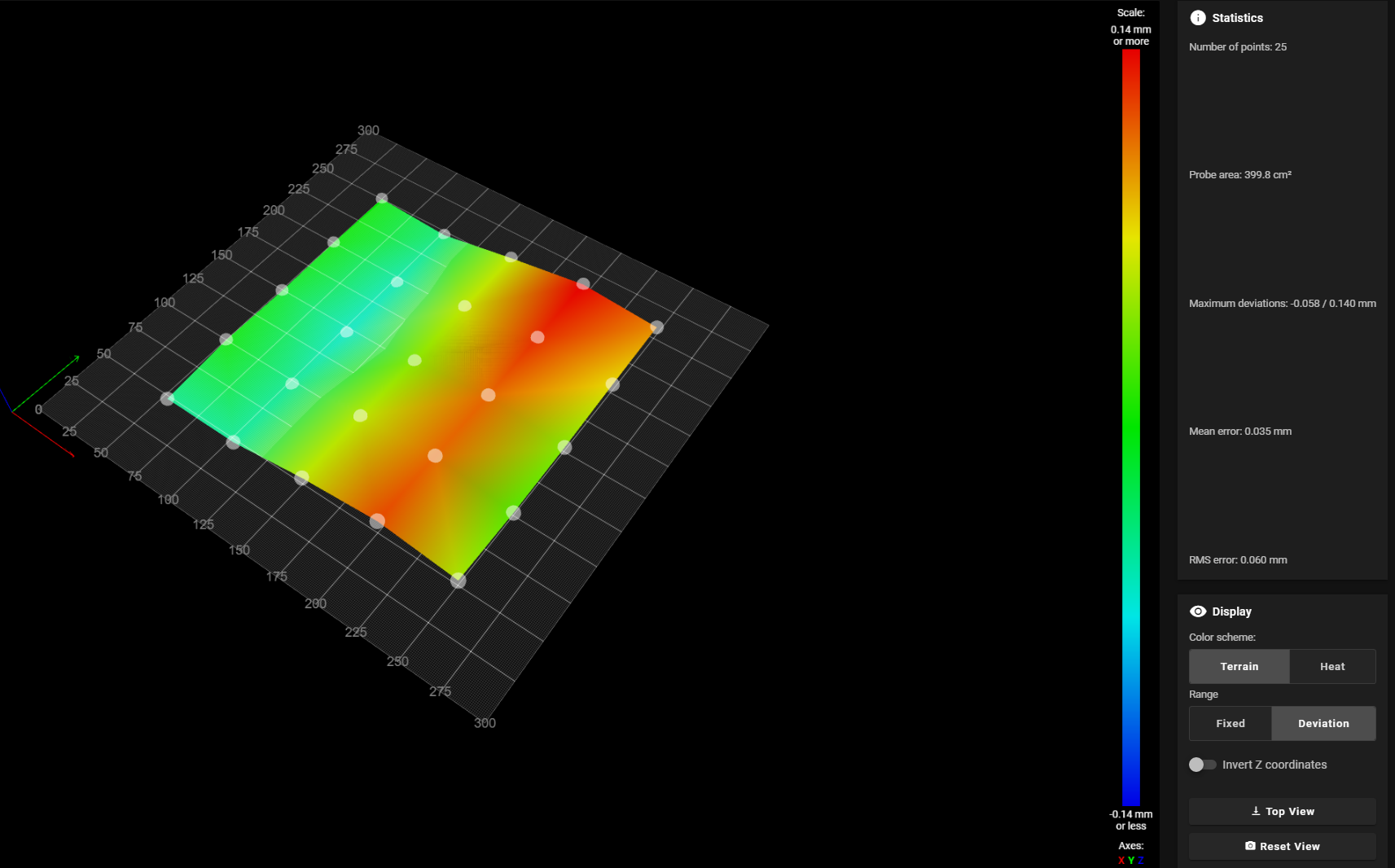Mesh Compensation active but still uneven first layer
-
-

-
@adamfilip You allow a -ve movement by specifying a -ve value for the lower limit of Z in the M208 command. But if the maximum -ve value in your mesh is less than your first layer height (say 0.2mm), then mesh compensation will not need to move below Z=0, so even if the firmware was limiting the -ve movement it should not be an issue. If you do allow movement below Z=0 then take care because that may allow the nozzle to hit the bed.
I'm sure your machine is well built, but it only takes a very small twist to cause problems. I'd really recommend trying the test I have described above. It will allow you to get a better feel for how your printer is working and the shape of the bed. It is tedious but usually worth the effort.
Have you tried printing with the mesh disabled? That will also give you a good idea of the actual shape of the bed (as seen by the nozzle) and would also be a good way to check how well the probing you have matches the actual bed shape.
Your mesh seems to show a ripple, if you rotate the FR4 surface through 90 degrees does the ripple change with it?
One final point, I'd strongly recommend homing Z such that the X/Y position of the probe matches exactly one of your probe points. If you do that, then the selected point should always be very close to 0 in the mesh. Having a point like this allows you to do a quick sanity check on the mesh, to ensure that nothing "odd" is happening with it.
-
@gloomyandy I did three tests
genered 3 new meshes using ProbeAlum Bed with FR4 Sheet

Alum Bed with FR4 Sheet turned 90 degrees counter clockwise

Alum Bed without FR4 Sheet

-
@adamfilip
Basically the same image, although the print bed has been rotated.
If you have a straightedge, check your x-axis.
It looks like it is not straight but has a wave.Google Translate
--- Original Text ---Im Grunde genommen das gleiche Bild, obwohl das Druckbett gedreht wurde.
Wenn Du ein Haarlineal hast, dann prüfe mal Deine X-Achse.
Es sieht so aus als wäre sie nicht gerade sondern hat eine Welle. -
@adamfilip said in Mesh Compensation active but still uneven first layer:
M558 K0
You only have a single probe, so remove the K0. When you change settings in your other macros you don't include K0 to target the probe so some settings may be getting reset or misapplied.
So either remove the K0, or use it consistently and re-create your mesh.
-
I dont see how it would be possible for the X or Y axis to not be straight, using 20x20 Vslot alum extrusion, and using Exoslide Carriages, the motion is smooth, it would bind if it has a bend in it. extrusion is generally super straight. I really dont think this is the issues here
-
@adamfilip
If you turned the FR4 plate by 90° and the mesh looks almost the same, then it can only be because of the X-axis.
A mirror is generally one of the flattest surfaces, if you have a mirror the size of your print bed then create a mesh with it.
If it looks the same as the previous meshes, then the aluminum profile must have a wave.While it won't have anything to do with the apparently flipped heightmap, it does explain the almost identical meshes of the three measurements you took.
Google Translate
--- Original Text ---Wenn Du die FR4 Platte um 90° gedreht hast und das Mesh sieht fast gleich aus, dann kann es ja nur an der X-Achse liegen.
Ein Spiegel ist im allgemeinen eines der ebensten Oberflächen, wenn Du einen Spiegel in der Größe Deines Druckbettes hast, dann erstelle damit mal ein Mesh.
Sollte es gleich aussehen wie die vorherigen Meshes, dann muss das Alu-Profil eine Welle haben.Es wird zwar nichts mit der anscheinend umgedrehten Heightmap zutun haben, aber es erklärt die fast identischen Meshes der drei Messungen die Du gemacht hast.
-
@norder When I choose a homiung point that represented the lowest point on the bed. so it didnt go into negatives when I did the mesh levelling, it worked fine.
choosing a homing point thats higher than the lowest point, seems to be messing up mesh compensation.
-
@adamfilip said in Mesh Compensation active but still uneven first layer:
choosing a homing point thats higher than the lowest point, seems to be messing up mesh compensation.
The points are relative to the Z0 point and it can go below the zero point no problem.
-
@phaedrux But yet it wasnt.

